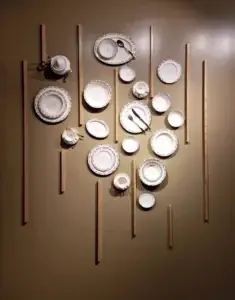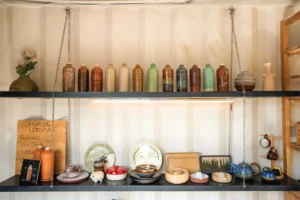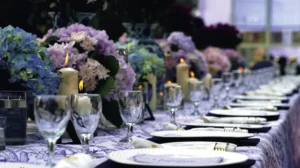SUASIVE SENSES

TRAVEL BACK TO THE ROOT WITH JATRA
For now, you forget that you are in Dhaka city and go back to the rural roots. Thankfully, Jatra has made it possible in this city. Amidst the rigid and chaotic city life of Dhaka, if you need a break, miss the rural natural vibe, and want to have a warm and cozy time with a vegetarian meal in a colorful, mesmerizing rural Bengal ambiance with folk music, then surely “JATRA” is the place to visit. Imagine, on a moonlit night, you’re sipping tea under the sky, and a mesmerizing flute is blessing your ear; the breezy sound of the thatched roof plays along with the music. You look around and see the mud-textured wall, bamboo trees, fences, and traditional local art everywhere. For now, you forget that you are in Dhaka city and go back to the rural roots. Thankfully, Jatra has made it possible in this city. Amidst the rigid and chaotic city life of Dhaka, if you need a break, miss the rural natural vibe, and want to have a warm and cozy time with a vegetarian meal in a colorful, mesmerizing rural Bengal ambiance with folk music, then surely “JATRA” is the place to visit. Jatra was created in the year 2000 in Banani by artist and musician Anusheh Anadil to highlight Bangladesh’s folk arts and crafts. Harmony with nature is one principle philosophy of Anusheh. In Bengali, Jatra means ‘journey.’ The people and culture of Bangladesh are vibrant, and everywhere the “Jatra” is visible, that vibrancy and harmony are visible. The art and music lounge of Jatra is “Jatra Biroti.”. In 2023, Jatra was relocated a few buildings away, close to their previous address. The design is done by the “Roofliners_studio of architecture” in association with “Charuta” as the construction partner. Late Ar. Rajib Ahmed, Ar. Tesha Sarawat, and Ar. Monon Bin Yunus played an important part in the design of “Jatra.” They have shared their journey of designing “Jatra” with us. Ar. Tesha Sarawat said, “We are connected to Jatra from the very beginning. As a designer, as a friend, as an acquaintance, we contain the philosophy as well. The harmony of nature and human beings is the philosophy of Anusheh. We also believe that this helped us design the place. Jatra was a fun project. Guidelines were there; also, there was full freedom of designing. The experiment was there too. Adding, eliminating, and adapting from the mistake was the design principle that we’ve followed. We have got a building with a field. We have designed the entry in a welcoming way so that any passerby feels like entering the place without even realizing when they have entered. The performance space is seen from the road. Jatra wants to go closer to people and wants to take people closer to nature. It was all kept in mind while designing.” The main challenge was that the building was very small and congested when they got it. Small rooms, one door, like an old residential house. Also, the structure was brick. So they couldn’t break wherever they felt like. It was impossible without expert engineering advice. Eng. Mashroof Kabir was there, who advised on where to break and where not to, keeping the structure stable. In this way, the whole place became like an interconnected floor. So that, when you go inside, you become confused about the entry and exit, like a maze. Which is strategically good for a showroom design and is intentionally done in this way. The thatched hut, with a mud-textured wall with traditional ìPuthi artî throughout the wall continuing up to the roof in some places, bamboo seating, and a small ìgamchaî patterned flag with cozy and warm light, ensures very selective usage of interior detailing and the right execution of the concept of distinct rural Bengal ambiance. “One big multipurpose hall was added later; one structure of mango wood was added. One kitchen of the restaurant was added on the roof. Structurally, the building was two-and-a-half-storied. It was not very fragile itself. But the addition we were supposed to do could not be mistaken. No technical mistakes could be made while modifying. Keeping the permanent part, many things would be added to the design journey that we have decided on at the beginning of the design. Then we did this. It’s continuing. Every year something will be added. That is the journey. Jatra Biroti is the restaurant part, but the whole philosophy is jatra”, said Ar. Monon bin Yunus. It was just a building with a field. Old, but not very old. There was a plinth in the front, which is the hall room now. The plucked structures are not very permanent. Mango wood, hemp (Shaun), and tin are the types of materials that are used. The hall room is an important function but gives the vibe of a temporary structure. Plus, “jatra biroti,” the restaurant part has an extension on the ground floor, which is also of mango wood structure and hemp (Shaun). The restaurant part also continues on the roof and the top roof. Some interesting elements, like blocks and dice of blocks, are used on the roof. The old staircase is also there as an exhibit. Reusing almost everything from the old “jatra” is seen everywhere. The thatched hut, with a mud-textured wall with traditional “Puthi art” throughout the wall continuing up to the roof in some places, bamboo seating, and a small “gamcha” patterned flag with cozy and warm light, ensures very selective usage of interior detailing and the right execution of the concept of distinct rural Bengal ambiance. The courtyard, or “Uthan, is the most original and core architectural element of every rural Bengal homestead. This courtyard is the main attraction of “Jatra Biroti,” surrounding which is all the thatched-roof lower seating area in a small raised plinth with bamboo-silted woven curtains and colorful artworks. The idea behind it was to recreate a traditional courtyard of the delta. To build a warm, inviting
Read More
Spilling teas from Monno Tea Room
After establishing a glorious legacy of around four decades, Monno Ceramics not only made a mark in the people’s hearts but also in their households. Now that it has stretched its new endeavour into a restaurant, one must wonder if it was only organic to come up with the idea since Monno already has its hands on the core ingredient of any eatery, which is tableware!
Read More
Becoming one with a Clay
You perhaps didn’t think you could come closer to clay in this crowded and bustling city of Dhaka in a manner that is both therapeutic and entertaining at the same time. However, there is a cozy little pottery studio hidden away on the periphery of Dhaka city, for you to escape to and rejoice in the fluidity of clay. Clay Station Dhaka, the pottery studio, which is a brainchild of Sharmin Ahmed and Co-founded by Sayeed Chowdhury, is a gift to Dhaka dwelers in the form of a healthier entertainment choice. Growing up, we had many outdoor entertainment options like going cycling, playing, venturing into adventures with comrades, but then our options are condensed into just being restaurants, cafes or a screen at home. Clay station emerged from the unfulfilled need of a creative source of amusement or even distraction of the good kind. From traveling around the world, both Ms Sharmin and Mr Sayeed experienced the abundance of recreational activities, to choose from, in the developed countries. In contrast to which they felt a stark lack of recreational choices would aid in unveiling one’s creativity or imagination, here in Dhaka. The founders stumbled upon the idea while visiting a pottery studio in the United States of America, where they laid witness to the magical property of clay in bringing people of all ages, gender, race or ability together in a fun and engaging way. Ms Sharmin recalls a couple in their 60s on a blind date getting to know each other through an engaging pottery painting session. She says, “Pottery could be a great choice for ice-breaking. It is calming yet it could be interactive too.” Neither being from the Ceramics background, they embarked upon this testing journey of creating a platform for the youth of Dhaka city, to indulge in creative activities that resonate with nature. The two spotted an untapped potential in the entertainment industry in Bangladesh which led them to put their business acumen and professional experience into play to build the pottery studio. They gathered ceramic graduates from Charukola and Santiniketan, India to provide and guide the patrons with the services and products they offer today. Being the pioneer in setting up a pottery studio in Dhaka, they both had to face numerous challenges. There being no pre-existing market for pottery meant sourcing for the ingredients and machines was difficult. They learnt that even the most basic of pottery ingredients like the china clay cannot be found in the local market and using the red clay found in abundance at the riverbanks would reduce the functionality as they could not be painted on or put under high temperature. So they started to source the imported clay from local suppliers and the ceramic glaze for tableware is imported from the USA, the UK or India as it is not available here in a safe composition and contains lead which can lead to lead poisoning. The wheels are imported from Japan, as these automated Japanese pottery wheels are more user-friendly and convenient. They also started to procure porcelain clay from a leading ceramics manufacturing company, Artisan Ceramics Ltd., to make the small keepsakes to paint on at the studio. Clay Station was created to offer cherished and memorable experiences to its patrons. And they wanted to ensure the experience would be the safest they could offer. But as a result of having to import the ingredients in use, the price of the sessions with clay at the studio goes up. Ms Sharmin says, “We wanted to create the safest environment for people to come and indulge in our services. And while ensuring the safety of our patrons and the sustainability of Clay Station, we have to keep the pricing as is and work to create awareness among the people of the therapeutic properties of clay.” “The inspiration to keep pushing forward with Clay Station, honestly, comes from our patrons. They are so appreciative of our initiative that we feel very hopeful about the work we’re doing and get the courage to take it further” Clay Station’s studio was initially located at the heart of Banani, over by the picturesque lake to complement the beautiful experience as a whole. Since then, the studio location has changed but without compromising on the experience. Ms Sharmin adds, “A pottery studio I believe should be closer to nature to enhance the whole experience.” Today, the studio is located at Chef’s Table Courtside which ensures a closeness to nature and also a family-friendly environment. Sunlight pours into this tranquil studio through the big glass windows. And as you look outside you discover yourself surrounded by greenery and the vast blue sky. And to preserve the authenticity of the studio, no plans of opening new branches are on the horizon. But instead, to make pottery more popular, small franchises at different offices or schools could be seen in the future. Even though the target audience were the youth, it was later found out that families with young children responded really well to the captivating activities that went on at the studio. Their three services, Pick and Paint, Pay with Clay and Throw at Wheel are innovative and a great way to relax, learn and explore. It is loved by the parents as it is so rare to find fun activities to do with kids. For Pick and Paint you pick one the cutest pre-made bisques from a range of shapes of a unicorn, puppy, airplane, cactus, and rainbows among many more and paint them in the brightest of colours and your imagination. It’s such a fun and creative activity for children and adults who want to feel young too. Play with Clay will allow you to get creative with a soft doughy clay ball and bring your imagination to life. You can follow your heart and see where that takes you. Chances are, you’ll end up with a meaningful keepsake of your own design which you can later in a week, come
Read More
Sygmaz’s Charismatic Anecdota
“A legacy of 20 years was not an easy journey, it’s easy to get on the peak, but the challenge was to hold on to that,” avowed Sigma Mehdi, Founder, and Creative Head of Sygmaz, a company with complete wedding solutions. It all started back in 2001 when young-newly married Sigma used to work half day for their family business, and the other half seeding this one-of-a-kind company along with a partner, which merely had any industry at that time. Enthusiast about sharing her journey, she segmented the two decades of an odyssey into four enthralling parts. In an industry that had no exposure and only a couple of executors, it was an act of courage to proceed without the availability of public or social platforms. In that time frame of 2001-2015, there had been no internet exposure to browse for ideas or look up to the international market for inspiration. It all happened with clusters of small thoughts and the urge to work in detail, which is still very prominent in the works of Sygmaz’s even after so many years. It is never to be in easy to the pioneer line of industry and keep a hold on it. The phases were not always smooth as her partnership broke in 2010, which partially helped the development due to her sole decision-making ability. In this timeline, the influence of social media boomed up the business. People were more interested in spending money as there started an online space to showcase their events. More companies came within the industry interested in collaborations; all these connectivities were hailed to the internet. “This idea of providing a complete solution is a new concept and will always provide a first mover’s luck,” said Sigma. Recently they started to introduce a 360-degree experience service for the clients, starting from invitations design to catering and entertainment, altogether running as a group of companies. It’s always the experience for the guests which matters more. The job is very taxing as the responsibility for someone’s dream day is never easy. Experience needs aesthetical approaches, starting from the buffet counter to the presentation of the tableware. There are customizations and requirements from the clients needed to be taken care of. This industry is in a constant procedure of improvement. “The mantra is to read the client’s mind. My clients are more comfortable because they can easily explain to me their desires,” added Sigma. “When I started, there was acceptance for the amateurs. But now the scenario has drastically changed due to the competition for betterment. It is never easy to be in the pioneer line of industry and keep a hold on it,” explained Sigma. She is from a complete business background and pulled off this creative profession gracefully. Currently, nine architects are working as a part of the design team. Extravagant and glamourous is what one feels and experiences attending the events curated by this extraordinary team of talented people, which is yet to have upcoming up-gradation with the next generations, maybe letting Sigma plan an early retirement from Sygmaz at its silver jubilee. Sigma Mehdi, Founder and Creative Head of Sygmaz Authored by Rehnuma Tasnim Sheefa
Read More
